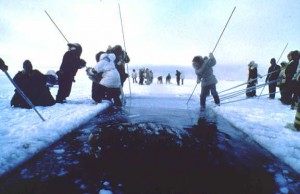The Real Story: ‘Big Miracle’ and the Alaskan Whale Rescue
Posted on February 2, 2012 at 3:59 pm
This week’s “Big Miracle” is about the real-life story of the 1988 rescue effort to save three trapped whales in Alaska. The film is based in part on Big Miracle, the book by journalist Tom Rose, who covered the story. As portrayed in the film, the rescue became a national news story and the turning point was an unprecedented phone call from President Ronald Reagan to the Soviet Union to get the cooperation of a Soviet ice-cutting ship. And as also portrayed in the film, the story attracted more than 150 journalists from around the world to tiny, frozen Barrow, Alaska, lat. 71°23’N and long. 156°30’W, where the locals charged them outrageous amounts for transportation, lodging, and equipment. The affectionate nicknames given to the whales were not the Flintstones character names depicted in the movie. The rescuers called the whales Crossbeak, Bonnet, and Bone. Possibly the most improbable story in the movie is the one that is closest to the truth. The White House aide working on coordinating the President’s involvement and the military officer working on the rescue in Alaska did fall instantly in love. Stay through the credits and you will see their wedding photo.
The film focuses on the challenges of the arctic conditions and the bigger challenges of finding a way for the humans to set aside their differences for a common goal. It also touches on some ot the darker themes Rose addresses more extensively in his book, as indicated by its original title: Freeing The Whales: How the Media Created the World’s Greatest Non-Event Rose points out that the Soviet ice-cutting ship portrayed in the media of the time and the movie of today as the whale-saver was actually in Alaska as a part of the USSR’s whale-slaughter industry, the largest in the world at the time of the rescue and for many years after. Rose’s book explores the role of the media in what a cynical character in the movie calls “cat up a tree” stories. The rescue of the three whales had enormous public appeal, but all around it were stories the media overlooked that were more important by any measure. Rose calculated that the cost of the rescue and media coverage was more than $5.7 million.
“e came to tell the world about a common occurrence,” he wrote “the routine stranding of three whales under a patch of ice. The only thing that made this stranding extraordinary was that it happened just 20 miles from a satellite uplink earth station. Had the facility been located far away, these whales, like dozen of others each year, would have died ordinary deaths.”
The movie shows how all of the participants in the rescue used or tried to use the media for their own purposes, including Greenpeace, which had to bring in more people to answer phones as calls came in from all over the world and the oil man portrayed in the film by Ted Danson. Rose writes:
The $500,000 ARCO spent on Operation Breakout was one of the best investments it ever made. A $20 million public relations campaign couldn’t have bought a tenth the goodwill ARCO earned helping free the three trapped whales. It seemed to be perfect timing. ARCO cashed in at a critical juncture in the history of the slumping Alaskan oil industry. No oil company in Alaska ever received more favorable press coverage than ARCO did during its two week investment in Operation Breakout. Usually the rich whipping boy of the environmentalists, ARCO now worked side by side with Cindy Lowry and Greenpeace. In the game of P.R. Pac-Man, ARCO swallowed any hint of criticism by pouring tremendous resources into a rescue destined to save three animals endangered by nature, not man’s insatiable carving for fossil fuels.
Of course, ARCO’s work on behalf of the three whales stranded in Barrow did nothing to clean up its share of the more than 11,000 acres of North Slope Arctic tundra the Environmental Protection Agency said were ruined by oil drilling.
We don’t know what happened to the whales who made it out. We do know that the media has changed in many ways since 1988 but still focuses on cute, upbeat, human (and animal) interest stories instead of big, complicated, less upbeat stories. The same could be said for “inspired by a true story” movies, but this one has enough respect for its audience to include a witty coda that is sure to spark some worthwhile conversations.


It’s a brilliant portrayal of how man can come together and do so much to help save not just one, but three of the most beautiful creatures on earth. It’s such a shame that he cannot do the same with each other to stop wars and conflict?
Thank you for that thoughtful comment, Steve, much appreciated. I hope this movie inspires others to ask that question.
the BIG MIRACLE is a great movie—i do not believe that it truly failed at the box office—some people are so blind—but just like ”IT’S A WONDERFUL LIFE”’–was not received well–but later on—so will this great movie–they should make more of this type of ocean life and MORE EMPHASIS ON THE UNDERWATER ICESHELF THAT WAS MAGNIGICENTLY SHOWN BUT NOT ENOUGH OF IT….thankyou for the movie–it was well done.